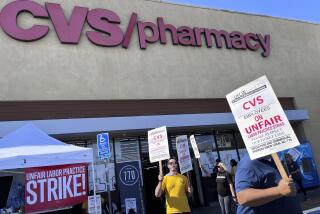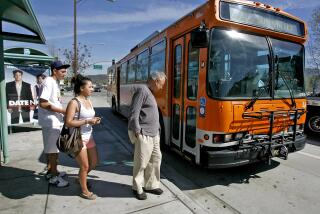Riders Jubilant as Strike Ends
When buses and trains started rolling again Tuesday morning, Eva Diaz cried.
Elisa Zapien treated herself to breakfast at Grand Central Market.
Jason Serna set off to see his probation officer.
By late Tuesday, about 85% of buses were rolling again and nearly half the trains, as employees of the Metropolitan Transportation Authority streamed back to work after a grueling 35-day strike.
Passengers joked and greeted one another on familiar lines, and the buses smelled clean and new.
“I thank God,” said Diaz, 56, of Sylmar. For the past month, she had feared losing her job at a food-packing plant in Sun Valley, depending on her children and an 83-year-old neighbor for daily rides.
Along the Blue Line light rail in South Los Angeles, stations that had been deserted suddenly filled with commuters, from downtown-bound businessmen to backpack-carrying teenage boys who raced across busy streets to catch their trains.
“Today I was going to take a taxi, but then I saw the trains and I thought, Thank heavens!” said Lolita Campo, 55, throwing up her hands in delight. Since the strike, Campo has been taking taxis and depending on rides from friends to get to her job at Cedars-Sinai Medical Center.
“I was so glad to see them,” Campo said.
The strike that shuttered the nation’s third-largest public transportation system ended early Tuesday, five weeks to the day after it began, as buses rolled out of 11 MTA yards just before dawn.
“I was glad that it was over,” said driver Tasha Jackson. The 27-year-old MTA employee reported for a 2 p.m. shift on Tuesday, piloting her coach down San Pedro Street. “The money that I had put up [to deal with the strike] was getting low.”
The Amalgamated Transit Union, Local 1277, whose members called the strike, was scheduled to vote today on whether to accept the deal that settled the work action. Under the plan, which is supported by the local’s president, Neil Silver, mechanics will receive a roughly 6% wage increase over the three-year, nine-month contract.
But the health-care issues at the heart of the dispute have not yet been resolved: The MTA still wants to limit the amount of money spent for health insurance for the union’s 700 retirees, and the union still opposes that. If the mechanics approve the deal worked out in marathon sessions last weekend, the health-care issues will be submitted to a three-person panel of mediators who will work out a compromise.
Many of the mechanics are waiting for the results of the vote before heading back to work -- just 30% of their ranks returned on Tuesday, compared to 70% of the agency’s union drivers. Voting will take place at the Los Angeles Convention Center at 9 a.m.
Ben Aguilar, a second-generation MTA employee who remembers his family going on welfare when his mechanic father was on strike years ago, said he is eager to return once the vote has been taken.
“I’m really glad to go back,” he said. “I’m just relieved that it’s over.”
For its part, the MTA greeted the start-up of its bus lines with an early morning photo opportunity and the promise of free rides through Saturday.
“I’m excited,” said MTA Deputy Director John Catoe. “It’s the first time since the strike started that I’m starting to feel whole again.”
Catoe said full service will be restored on the Red Line Subway and the Blue Line light rail train, which are currently running on abbreviated routes and less frequently than normal, by Friday or Saturday. MTA will honor October and November bus passes through the end of the year.
The still-shuttered Gold Line and Green Line will start up Thursday, Catoe said.
But scars from the strike were still evident Tuesday.
Riders converged on waiting rooms of clinics and hospitals they could not reach before the buses stopped running. Students continued to miss classes at Los Angeles High School, where principal Mary Kaufman figures they or their parents weren’t sure that the buses were really rolling again. The school suspended its tardy policy during the strike, and doesn’t anticipate reinstating it until next week.
At the Los Angeles Community Adult School, where 500 of 4,000 students stopped coming to class after the strike started, administrators fear that they will have to lay off teachers -- even though the strike is over. Principal Claudine Ajeti said that the school is reimbursed by the state based on the number of hours that pupils attend, and that revenues would drop steeply as a result of the strike. To encourage students to come back, she said, the school sent out 1,200 postcards, promising adult learners that the school would help them make up for missed lessons by starting many classes over.
At St. John’s Well Child and Family Clinic near downtown, patient visits had dropped off significantly during the strike because people didn’t have a way to get to the free clinic. On Tuesday, 90 patients showed up unannounced by lunchtime, said clinic director Jim Mangia. By early afternoon, there were no more seats in the waiting room, and patients were standing, crowded together, hoping to see doctors and dentists.
“We’re absolutely swamped” said Mangia.
Santiago Chavez, 28, waited at the clinic, his body sweaty and his voice raspy from a flu-like condition that he said had plagued him for several weeks.
Chavez said he watched the news every night for the past two weeks, waiting for word that the strike had been settled so he could seek care. He said without a bus he had no way to get from his Westlake district home to the downtown clinic.
At Olive View Medical Center in Sylmar, a county hospital whose patients were particularly hard-hit by the transit strike, the emergency room was “busting at the seams” with patients who had put off treatment during the strike, said cardiologist Sheba Meymandi. In the cardiology clinic, Meymandi said, she treated three patients who had heart failure after the strike made it difficult for them to replenish their medication.
Traffic volume, which officials estimate rose about 4% during the strike as commuters rented or borrowed cars, or hired taxis, to get around, didn’t drop appreciably on Tuesday, said California Highway Patrol spokesman Vince Ramirez. “In the middle of rush hour, it still looks pretty much the same,” Ramirez said.
The same was true for city streets, where extra congestion that begin with the strike continued, said Officer Tim Ruiz of the Los Angeles Department of Transportation’s central traffic division. “People still don’t know that the strike is over,” Ruiz said. “And not all the buses are running.”
On Washington Boulevard, people approached bus stops warily, asking those already waiting in hushed voices whether the buses really were running. Vehicles were full in some neighborhoods, and half-empty in others, as riders tried to figure out which buses and trains were on, and which weren’t back in service yet.
Brenda Sanders, 49, a South Los Angeles resident who boarded Jackson’s bus on San Pedro Street on her way home, was ebullient, declaring that she jumped up and screamed when she heard the strike was done.
“I ride every day, but during the strike I had to walk,” she said. “I ran out of two pairs of shoes with all the walking I did.”
*
Times staff writers Hector Becerra and Patrick McGreevy contributed to this report.
More to Read
Sign up for Essential California
The most important California stories and recommendations in your inbox every morning.
You may occasionally receive promotional content from the Los Angeles Times.










